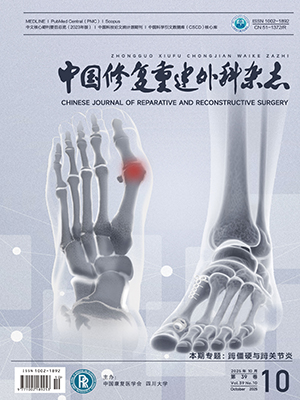Objective To investigate of effectiveness of free fascia lata flap assisted by indocyanine green angiography (ICGA) in treatment of Myerson type Ⅱ and Ⅲ chronic Achilles tendon ruptures. Methods A clinical data of 14 patients with Myerson type Ⅱ and Ⅲ chronic Achilles tendon ruptures between March 2020 and June 2024 was retrospectively analyzed. All Achilles tendon defects were repaired with the free fascia lata assisted by ICGA during operation. There were 12 males and 2 females with an average age of 45.4 years (range, 26-71 years). The causes of Achilles tendon rupture included sports injury in 10 cases, Achilles tendon-related tendinopathy in 3 cases, and glass laceration injury in 1 case. The time from Achilles tendon rupture to operation was 4-40 weeks (median, 4.5 weeks). Preoperative MRI examination showed that the defect length of the Achilles tendon was 2-5 cm (mean, 3.2 cm). The operation time and intraoperative blood loss were recorded. The color Doppler ultrasound (CDU) and MRI were taken to observe the foot blood vessels and the tendon healing. The visual analogue scale (VAS) score, American Orthopaedic Foot and Ankle Society (AOFAS) score, Achilles Tendon rupture score (ATRS), and range of motion of the ankle joint were used to estimate the pain and function of ankle joint. Results All operations of the 14 patients were successfully completed. The operation time ranged from 3.00 to 4.50 hours (mean, 3.60 hours). The intraoperative blood loss ranged from 10 to 50 mL (mean, 36.4 mL). After operation, 1 patient had exudation at the recipient site, which healed after dressing change; the other incisions healed by first intention. All incisions at the donor sites healed by first intention. All patients were followed up 6-36 months (mean, 11.4 months). The CDU of the foot at 1 month after operation showed that the blood flow signal of the perforating vessels of the fascia lata flap was clear. The ankle MRI at 2 months after operation showed the good continuity of the Achilles tendon. No complication such as the Achilles tendon re-rupture, ankle stiffness, or scar contracture occurred during follow-up. Compared with preoperative score, the AOFAS score, ATRS score, and plantar flexion range of motion significantly increased at 1, 3, and 6 months after operation (P<0.05), while the VAS score and dorsiflexion range of motion significantly decreased (P<0.05). The AOFAS score, ATRS score, and VAS score at 3 and 6 months further improved when compared with those at 1 month (P<0.05); however, there was no significant difference in the range of motion of the ankle joint (P>0.05). There was no significant difference in above indicators between 3 and 6 months after operation (P>0.05). Conclusion The treatment of Myerson type Ⅱ and Ⅲ chronic Achilles tendon ruptures with free fascia lata flaps under the guidance of ICGA has the advantages of precise design, fast healing, and a wide range of adaptability.
Citation:
GUO Liping, ZHOU Rong, JU Jihui, JIN Guangzhe, YANG Liang, GENG Chao. Effectiveness of free fascia lata flap assisted by indocyanine green angiography in treatment of Myerson type Ⅱ and Ⅲ chronic Achilles tendon ruptures. Chinese Journal of Reparative and Reconstructive Surgery, 2025, 39(5): 620-627. doi: 10.7507/1002-1892.202503020
Copy
Copyright © the editorial department of Chinese Journal of Reparative and Reconstructive Surgery of West China Medical Publisher. All rights reserved
| 1. |
|
| 2. |
冯仕明. 陈旧性跟腱断裂手术治疗的现状与挑战. 中华外科杂志, 2024, 62(6): 520-524.
|
| 3. |
|
| 4. |
|
| 5. |
|
| 6. |
|
| 7. |
|
| 8. |
|
| 9. |
|
| 10. |
|
| 11. |
|
| 12. |
|
| 13. |
|
| 14. |
|
| 15. |
|
| 16. |
|
| 17. |
|
| 18. |
|
| 19. |
|
| 20. |
|
| 21. |
|
| 22. |
|
| 23. |
|
| 24. |
|
| 25. |
|
| 26. |
|
| 27. |
|
| 28. |
|
- 1.
- 2. 冯仕明. 陈旧性跟腱断裂手术治疗的现状与挑战. 中华外科杂志, 2024, 62(6): 520-524.
- 3.
- 4.
- 5.
- 6.
- 7.
- 8.
- 9.
- 10.
- 11.
- 12.
- 13.
- 14.
- 15.
- 16.
- 17.
- 18.
- 19.
- 20.
- 21.
- 22.
- 23.
- 24.
- 25.
- 26.
- 27.
- 28.




